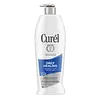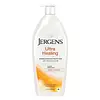What's inside
What's inside
 Key Ingredients
Key Ingredients

 Benefits
Benefits

 Concerns
Concerns

 Ingredients Side-by-side
Ingredients Side-by-side

Water
Skin ConditioningGlycerin
HumectantDistearyldimonium Chloride
Petrolatum
EmollientIsopropyl Palmitate
EmollientCetyl Alcohol
EmollientDimethicone
EmollientMethylparaben
PreservativeEthylparaben
PreservativeParfum
MaskingSodium Chloride
MaskingCetyl-Pg Hydroxyethyl Palmitamide
Skin ConditioningButylene Glycol
HumectantButyrospermum Parkii Butter
Skin ConditioningEucalyptus Globulus Leaf Extract
PerfumingSodium Lauroyl Lactylate
EmulsifyingAcacia Senegal Gum
MaskingGelatin
Ceramide NP
Skin ConditioningCeramide AP
Skin ConditioningAcetylphytosphingosine
Skin ConditioningCarbomer
Emulsion StabilisingXanthan Gum
EmulsifyingCeramide EOP
Skin ConditioningWater, Glycerin, Distearyldimonium Chloride, Petrolatum, Isopropyl Palmitate, Cetyl Alcohol, Dimethicone, Methylparaben, Ethylparaben, Parfum, Sodium Chloride, Cetyl-Pg Hydroxyethyl Palmitamide, Butylene Glycol, Butyrospermum Parkii Butter, Eucalyptus Globulus Leaf Extract, Sodium Lauroyl Lactylate, Acacia Senegal Gum, Gelatin, Ceramide NP, Ceramide AP, Acetylphytosphingosine, Carbomer, Xanthan Gum, Ceramide EOP
Water
Skin ConditioningGlycerin
HumectantCetearyl Alcohol
EmollientPetrolatum
EmollientStearic Acid
CleansingC12-15 Alkyl Benzoate
AntimicrobialAluminum Starch Octenylsuccinate
AbsorbentDimethicone
EmollientLaureth-3
EmulsifyingCeteareth-20
CleansingAllantoin
Skin ConditioningArginine
MaskingSodium Hydroxide
BufferingCarbomer
Emulsion StabilisingParfum
MaskingPanthenol
Skin ConditioningLecithin
EmollientPentylene Glycol
Skin ConditioningAlcohol
AntimicrobialAscorbyl Palmitate
AntioxidantTocopherol
AntioxidantMethylparaben
PreservativePhenoxyethanol
PreservativeEthylparaben
PreservativeWater, Glycerin, Cetearyl Alcohol, Petrolatum, Stearic Acid, C12-15 Alkyl Benzoate, Aluminum Starch Octenylsuccinate, Dimethicone, Laureth-3, Ceteareth-20, Allantoin, Arginine, Sodium Hydroxide, Carbomer, Parfum, Panthenol, Lecithin, Pentylene Glycol, Alcohol, Ascorbyl Palmitate, Tocopherol, Methylparaben, Phenoxyethanol, Ethylparaben
 Reviews
Reviews

Ingredients Explained
These ingredients are found in both products.
Ingredients higher up in an ingredient list are typically present in a larger amount.
Carbomer is a polymer of acrylic acid. Its main role is to create a gel consistency.
A high amount of carbomer can cause pilling or balling up of products. Don't worry, most products contain 1% or less of carbomer.
Dimethicone is a type of synthetic silicone created from natural materials such as quartz.
What it does:
Dimethicone comes in different viscosities:
Depending on the viscosity, dimethicone has different properties.
Ingredients lists don't always show which type is used, so we recommend reaching out to the brand if you have questions about the viscosity.
This ingredient is unlikely to cause irritation because it does not get absorbed into skin. However, people with silicone allergies should be careful about using this ingredient.
Note: Dimethicone may contribute to pilling. This is because it is not oil or water soluble, so pilling may occur when layered with products. When mixed with heavy oils in a formula, the outcome is also quite greasy.
Learn more about DimethiconeEthylparaben is a preservative, is a paraben, and is not reef safe.
Glycerin is already naturally found in your skin. It helps moisturize and protect your skin.
A study from 2016 found glycerin to be more effective as a humectant than AHAs and hyaluronic acid.
As a humectant, it helps the skin stay hydrated by pulling moisture to your skin. The low molecular weight of glycerin allows it to pull moisture into the deeper layers of your skin.
Hydrated skin improves your skin barrier; Your skin barrier helps protect against irritants and bacteria.
Glycerin has also been found to have antimicrobial and antiviral properties. Due to these properties, glycerin is often used in wound and burn treatments.
In cosmetics, glycerin is usually derived from plants such as soybean or palm. However, it can also be sourced from animals, such as tallow or animal fat.
This ingredient is organic, colorless, odorless, and non-toxic.
Glycerin is the name for this ingredient in American English. British English uses Glycerol/Glycerine.
Learn more about GlycerinMethylparaben is a preservative and is a paraben. It is used to prevent the growth of fungus, mold, and other harmful bacteria. Parabens are chemicals used as preservatives in both cosmetics and food.
Methylparaben can be synthetically created. It can also be found naturally in some fruits, such as blueberries.
Oftentimes, Methylparaben is combined with other parabens to help increase the shelf life.
The safety of Methylparaben is currently being studied. While ongoing studies are looking into the safety of parabens, the results have been very mixed. Some studies have not found Methylparaben to be harmful.
Learn more about MethylparabenParfum is a catch-all term for an ingredient or more that is used to give a scent to products.
Also called "fragrance", this ingredient can be a blend of hundreds of chemicals or plant oils. This means every product with "fragrance" or "parfum" in the ingredients list is a different mixture.
For instance, Habanolide is a proprietary trade name for a specific aroma chemical. When used as a fragrance ingredient in cosmetics, most aroma chemicals fall under the broad labeling category of “FRAGRANCE” or “PARFUM” according to EU and US regulations.
The term 'parfum' or 'fragrance' is not regulated in many countries. In many cases, it is up to the brand to define this term.
For instance, many brands choose to label themselves as "fragrance-free" because they are not using synthetic fragrances. However, their products may still contain ingredients such as essential oils that are considered a fragrance by INCI standards.
One example is Calendula flower extract. Calendula is an essential oil that still imparts a scent or 'fragrance'.
Depending on the blend, the ingredients in the mixture can cause allergies and sensitivities on the skin. Some ingredients that are known EU allergens include linalool and citronellol.
Parfum can also be used to mask or cover an unpleasant scent.
The bottom line is: not all fragrances/parfum/ingredients are created equally. If you are worried about fragrances, we recommend taking a closer look at an ingredient. And of course, we always recommend speaking with a professional.
Learn more about ParfumPetrolatum is more commonly known as petroleum jelly. It is created by mixing waxes and mineral oils.
This ingredient is effective at reducing water loss by 99%. This is because it is an occlusive. Occlusives create a hydrophobic barrier on the skin to prevent evaporation. This property makes it great for hydrating dry skin.
Pro tip: Use occlusives, such as this ingredient, on damp skin for the best results.
The quality or origin of petrolatum is only known when disclosed by the brand. Most cosmetic petrolatum has gone through several purification stages.
Another benefit of occlusives is it protects your skin against infection or allergies.
Petrolatum may not be safe for fungal-acne. Studies show mineral oil / petroleum leads to the growth of M. Furfur, a type of yeast.
Learn more about PetrolatumWater. It's the most common cosmetic ingredient of all. You'll usually see it at the top of ingredient lists, meaning that it makes up the largest part of the product.
So why is it so popular? Water most often acts as a solvent - this means that it helps dissolve other ingredients into the formulation.
You'll also recognize water as that liquid we all need to stay alive. If you see this, drink a glass of water. Stay hydrated!
Learn more about Water